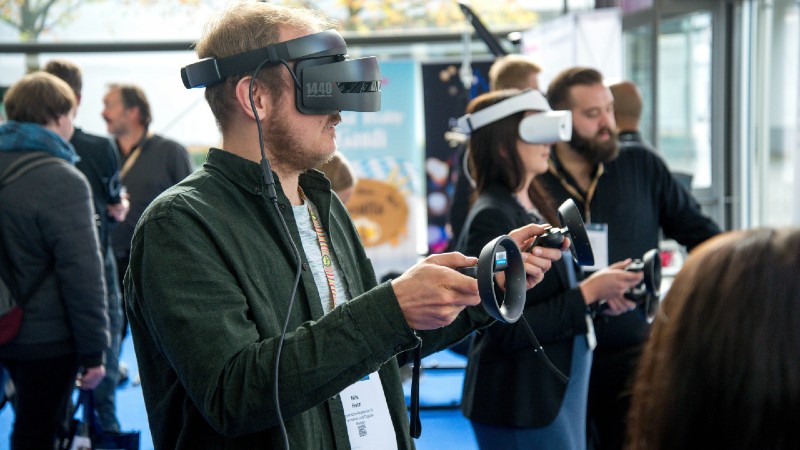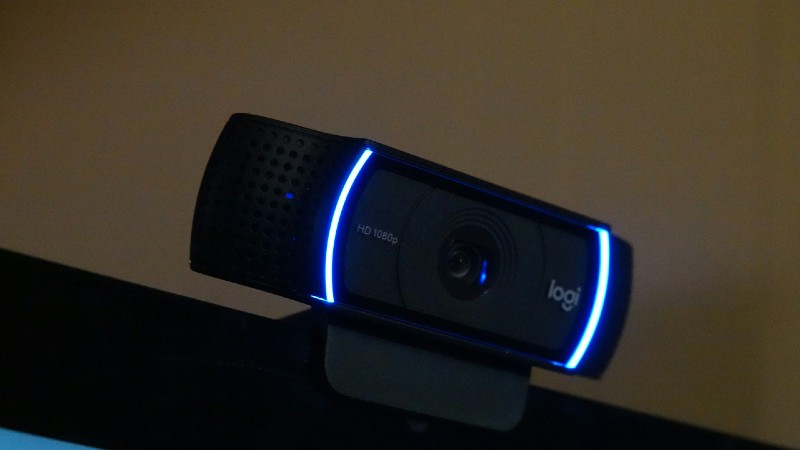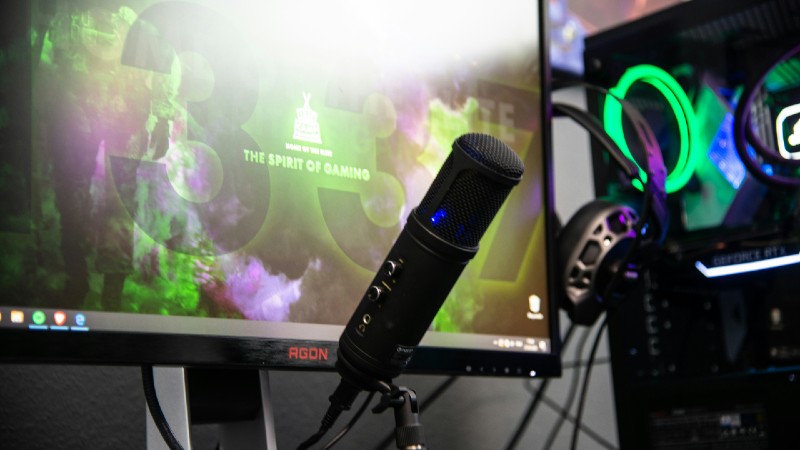Disclosure: As an Amazon Associate, we earn from qualifying purchases. This post contains affiliate links. Our reviews are based on extensive research, including customer feedback and specs, though we haven’t tested every product listed.
Virtual reality has transformed gaming over the past decade, and as we move deeper into 2025, the technology continues to evolve with sharper visuals, more immersive experiences, and greater accessibility. For gamers seeking to dive into virtual worlds, whether battling aliens in space or exploring fantastical realms, selecting the right VR headset is crucial. This year, standalone devices dominate the market, offering wireless freedom, while tethered options provide high-fidelity graphics for those with powerful setups. In this comprehensive guide, we’ll explore the top five VR headsets ideal for gaming: the Meta Quest 3 (512GB), PlayStation VR2, HTC Vive Focus Vision, Meta Quest 3S (256GB), and Pico 4 Ultra. Drawing from the latest reviews and comparisons, we’ll break down their features, strengths, and weaknesses to help you make an informed choice. These selections stand out for their performance in gaming scenarios, balancing innovation with practicality.
A Snapshot of the Contenders: Key Specs at a Glance
Before delving into detailed analyses, here’s a quick comparison table highlighting essential specifications. This overview captures core aspects like display quality, processing power, and connectivity, which are pivotal for gaming performance in 2025.
| Product | Price (Jul 2025) | Resolution (per eye) | Refresh Rate | Processor | Field of View (FOV) | Battery Life (approx.) |
|---|---|---|---|---|---|---|
| Meta Quest 3 (512GB) | $499 | 2064 x 2208 | 120Hz | Snapdragon XR2 Gen 2 | 110° horizontal | 2-3 hours |
| PlayStation VR2 | $399 | 2000 x 2040 | 120Hz | Custom (PS5/PC req.) | 110° | N/A (tethered) |
| HTC Vive Focus Vision | $1,238 | 2448 x 2448 | 90Hz | Snapdragon XR2 Gen 1 | 120° | 2 hours |
| Meta Quest 3S (256GB) | $393 | 1832 x 1920 | 120Hz | Snapdragon XR2 Gen 2 | 96° horizontal | 2.5 hours |
| Pico 4 Ultra | $1,385 | 2160 x 2160 | 90Hz | Snapdragon XR2 Gen 2 | 105° | 2-3 hours |
This table draws from aggregated data across recent evaluations, emphasizing how each headset caters to different gaming priorities— from budget-conscious wireless play to premium tethered immersion. Prices reflect current market listings, and features like refresh rates directly impact smoothness in fast-paced games.
Diving Deeper: Detailed Reviews and Head-to-Head Comparisons
In this section, we’ll examine each headset individually, highlighting pros and cons based on expert insights from 2025 reviews. We’ll also compare them in key gaming contexts, such as visual fidelity, comfort during extended sessions, and ecosystem support. These devices represent a mix of standalone and hybrid options, ensuring options for various setups.
Meta Quest 3 (512GB): The All-Around Leader for Wireless Gaming

The Meta Quest 3 stands as a benchmark for VR gaming in 2025, building on its predecessor’s success with enhanced processing and mixed reality capabilities. At 512GB, it offers ample storage for a library of games, making it ideal for standalone play without constant deletions.
Pros:
- Exceptional graphical processing power, twice that of earlier models, enabling smoother gameplay in demanding titles like Batman: Arkham Shadow.
- Wireless freedom eliminates cables, perfect for room-scale gaming where movement is key.
- High-resolution pancake lenses provide 30% sharper visuals, reducing screen door effect and enhancing immersion in open-world adventures.
- Vast ecosystem with thousands of apps and games, including exclusives and PCVR compatibility via Air Link.
- Color passthrough cameras allow seamless mixed reality experiences, blending virtual elements with the real world for innovative gameplay.
Cons:
- Higher price point compared to entry-level options, which might deter budget gamers.
- Battery life, while improved, still limits sessions to around 2-3 hours, requiring recharges for marathon gaming.
- Passthrough quality, though usable, isn’t as crisp as dedicated AR devices, potentially affecting mixed reality precision.
- Some users note the need for third-party accessories for optimal comfort during long playtimes.
- Limited exclusive AAA titles compared to console-tied headsets, relying more on indie and cross-platform content.
In comparisons, the Quest 3 outshines the PlayStation VR2 in standalone versatility— no console required— but falls short in OLED contrast for dark scenes. Against the HTC Vive Focus Vision, its newer processor ensures better performance in standalone mode, though the Vive edges out in FOV for panoramic views. For gamers prioritizing untethered exploration, this headset excels. Ready to elevate your setup? Explore the Meta Quest 3 512GB | Thirty Percent Sharper Resolution — 2X Graphical Processing Power — Play Without Wires — Get Batman: Arkham Shadow and a 3-Month Trial of Meta Horizon+ Included here.
PlayStation VR2: Premium Console Integration for Immersive Storytelling

Sony’s PlayStation VR2 continues to impress in 2025, especially with PC adapter support expanding its reach beyond the PS5. It’s tailored for narrative-driven games, leveraging haptic feedback and eye tracking for deeper engagement.
Pros:
- Dual 2K OLED HDR displays deliver vibrant colors and deep blacks, ideal for atmospheric horror or action games like Horizon Call of the Mountain.
- Eye tracking and foveated rendering optimize performance, focusing sharpness where you look to reduce hardware strain.
- Adaptive triggers and headset haptics add tactile realism, making interactions feel more lifelike.
- Wide compatibility now includes SteamVR, broadening access to PC titles without native PS support.
- Competitive pricing for the tech, offering high-end features at a mid-range cost.
Cons:
- Requires a PS5 or PC with adapter, limiting portability and adding setup complexity.
- Tethered design restricts movement compared to wireless rivals, potentially causing cable management issues.
- Smaller game library focused on Sony exclusives, with less emphasis on standalone indie content.
- No built-in audio adjustments for all users, though the included earbuds perform well.
- Heavier build may cause fatigue in prolonged sessions without breaks.
When stacked against the Meta Quest 3, the PSVR2 wins in visual depth thanks to OLED, but loses in wireless convenience— a trade-off for console gamers. Versus the Pico 4 Ultra, its haptic innovations provide a more sensory experience, though the Pico’s higher resolution offers crisper details. This headset suits those invested in the PlayStation ecosystem. Dive into enhanced realities with the PlayStation VR2 Horizon (PSVR2) here.
HTC Vive Focus Vision: High-End Hybrid for PC Enthusiasts

The HTC Vive Focus Vision refreshes the Focus line in 2025, emphasizing enterprise features but shining in gaming with eye tracking and lossless PC streaming.
Pros:
- High-resolution displays (2448 x 2448 per eye) and 120° FOV create expansive, detailed vistas for simulation-style games.mrtv.co
- Eye tracking enables dynamic foveated rendering, boosting efficiency in GPU-intensive titles.
- Lossless DisplayPort streaming to PC ensures zero compression artifacts for wired high-fidelity gaming.
- Comfortable weight distribution and built-in speakers enhance extended play without discomfort.
- Mixed reality passthrough supports blended environments, useful for strategy games with real-world overlays.
Cons:
- Outdated Snapdragon XR2 Gen 1 processor lags behind competitors in standalone performance, leading to occasional stutters.
- Fresnel lenses introduce some distortions, unlike the clearer pancake optics in rivals.
- Premium price doesn’t fully justify the specs when compared to more affordable options with newer chips.
- Software ecosystem is less robust, relying heavily on PC tethering for the best experiences.
- Battery life is shorter at around 2 hours, necessitating frequent charging or wired use.
In head-to-heads, it surpasses the Meta Quest 3S in resolution and FOV but trails the Quest 3 in processing speed and app variety. Against PSVR2, its standalone mode adds flexibility, though Sony’s haptics feel more integrated. For PCVR purists, this is a solid pick. Upgrade your rig with the HTC Vive Focus Vision VR Headset with DisplayPort PC Streaming Kit here.
Meta Quest 3S (256GB): Budget-Friendly Gateway to Modern VR

As a more accessible sibling to the Quest 3, the Meta Quest 3S brings 2025 VR advancements to a wider audience, sharing the same powerful chipset at a lower cost.
Pros:
- Same Snapdragon XR2 Gen 2 processor as the Quest 3, ensuring compatibility with high-end games and smooth multitasking.
- Affordable entry point with 256GB storage, making it easy to build a game collection without breaking the bank.
- Color passthrough and mixed reality features open up innovative gameplay, like augmented adventures in your living room.
- Improved battery efficiency over the Quest 2, supporting longer sessions.
- Vast Meta Horizon ecosystem provides endless gaming options, from free titles to premium releases.
Cons:
- Lower resolution and Fresnel lenses result in less sharp visuals compared to the Quest 3’s pancake setup.
- Narrower FOV (96°) can feel restrictive in wide-angle games.
- Bulkier design may not suit all head shapes comfortably without adjustments.
- Passthrough, while functional, lacks the vibrancy of higher-end models.
Compared to the Pico 4 Ultra, the Quest 3S offers a stronger app library but concedes in display clarity. Versus the Vive Focus Vision, its modern processor handles standalone better, though at the expense of resolution. Ideal for newcomers. Start your journey with the Meta Quest 3S 256GB here.
Pico 4 Ultra: Powerhouse for Tech-Savvy Gamers

The Pico 4 Ultra emerges as a strong contender in 2025, boasting upgraded hardware and optional body tracking for full-immersion experiences.
Pros:
- Dual 2160 x 2160 displays with pancake lenses deliver crisp, ghosting-free visuals for precise gaming.
- Snapdragon XR2 Gen 2 chipset and 12GB RAM handle demanding VR titles with ease.
- Lightweight build (under 600g) promotes comfort in long sessions.
- Optional Motion Trackers enable full-body tracking, enhancing realism in movement-based games.
- Competitive mixed reality via 32MP cameras, rivaling Meta’s offerings in clarity.
Cons:
- Ecosystem lags behind Meta, with fewer exclusive games and apps available.
- Controller ergonomics receive mixed feedback, potentially affecting precision in competitive play.
- Higher price reflects enterprise focus, which may not appeal to casual gamers.
- Passthrough colors appear muted compared to Quest models.
- Limited global availability and support in some regions.
In comparisons, it edges the Quest 3 in raw specs but falls short in software depth and community. Against PSVR2, its standalone nature wins for portability, though Sony’s exclusives draw narrative fans. For power users, this shines. Experience it with the New PICO 4 Ultra VR MR Headset 3D Wireless VR Glasses 6DOF Virtual Reality 4K Display for Steam Games Mac Windows Mobile All-in-one here.
Across these headsets, common themes emerge: Standalone models like the Quest series prioritize ease, while hybrids like the Vive and PSVR2 excel in fidelity with PC support. For pure gaming, the Quest 3’s balance often prevails, but PSVR2’s haptics transform story-driven titles. Budget plays a role—the Quest 3S offers 80% of the Quest 3’s power for less—while premium picks like the Pico and Vive cater to enthusiasts willing to invest.
Essential Factors When Choosing a VR Headset for Gaming
Navigating the VR market in 2025 requires focusing on several key elements to ensure your purchase aligns with gaming needs. Here’s what to consider:
- Display and Visuals: Look for high resolution (at least 2K per eye) and refresh rates of 90Hz or higher to minimize motion sickness in fast-action games. Pancake lenses, as in the Quest 3 and Pico 4 Ultra, offer edge-to-edge clarity over Fresnel alternatives.
- Performance and Processing: A robust chipset like the Snapdragon XR2 Gen 2 ensures lag-free play. Standalone capability is vital for wireless freedom, but check PCVR compatibility for graphically intensive titles.
- Comfort and Ergonomics: Weight distribution, adjustable straps, and IPD (interpupillary distance) settings prevent fatigue. Aim for under 600g for extended sessions.
- Ecosystem and Content: Meta’s vast library leads for variety, while Sony focuses on quality exclusives. Ensure the headset supports your preferred platforms, like SteamVR.
- Battery and Connectivity: For standalone use, 2+ hours of battery is standard; tethered options bypass this but add cables.
- Additional Features: Eye tracking (in PSVR2 and Vive) enhances realism, while mixed reality opens new gameplay avenues. Budget for accessories like controllers or straps.
- Price vs. Value: Entry-level like the Quest 3S suits beginners, but premiums offer future-proofing.
By weighing these, you’ll find a headset that matches your gaming style—whether casual mobile sessions or hardcore PC simulations.
Wrapping Up: Finding Your Perfect VR Companion in 2025
As VR gaming matures in 2025, these five headsets represent the pinnacle of what’s available, each excelling in specific niches. The Meta Quest 3 emerges as the versatile champion for most gamers, blending power and accessibility. For console loyalists, the PlayStation VR2 delivers unmatched immersion, while the HTC Vive Focus Vision and Pico 4 Ultra appeal to those seeking cutting-edge specs. The Meta Quest 3S proves that quality VR doesn’t have to be expensive. Ultimately, your choice depends on budget, setup, and preferences—standalone for freedom or tethered for depth. With advancements accelerating, now’s an exciting time to invest. Whichever you select, these devices promise to redefine your gaming horizons.




